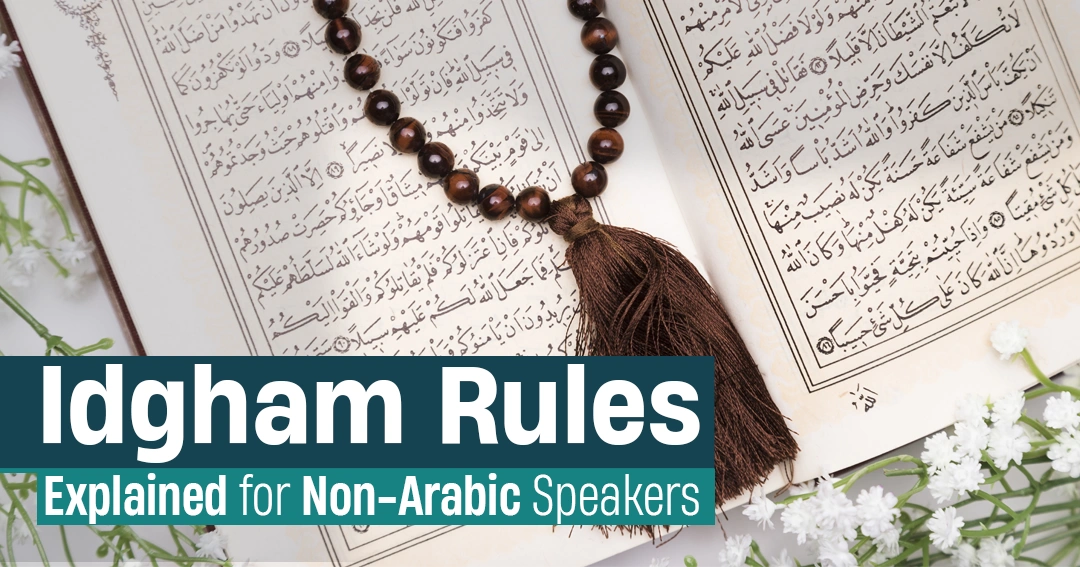Idgham rules for non-native speakers might seem difficult but with the right guidance and practice it will be easier than ever. Therefore, in this article we will explore the various rules of Tajweed, examples from the Quran, and more.
What is Idgham?
The word Idgham in Arabic means “merging” or “blending.” In the context of Tajweed, it refers to the merging of one letter into another to produce a smoother, more fluent sound during recitation.
Specifically, Idgham happens when a Noon Saakinah (نْ) or Tanween (ً ٍ ٌ) is followed by one of the Idgham letters. This merging enhances the flow and beauty of Quranic recitation. Learning Idgham rules for non-native speakers is an essential step to avoid choppy or unclear pronunciation.
Types of Idgham
To make your learning journey easier, here’s a simple visual breakdown of the Idgham rules for non-native speakers. This table summarizes the two types of Idgham, the letters involved, whether a nasal sound (ghunnah) is required, and an example from the Quran for each.
| Type of Idgham | Letters | Nasal (Ghunnah) | Example |
| Idgham with Ghunnah | ي، ن، م، و (Yā, Nūn, Mīm, Wāw) | Yes | مَنْ يَقُولُ → ma-y-yaqūlu |
| Idgham without Ghunnah | ل، ر (Lām, Rā) | No | مِنْ رَبِّهِمْ → mir-rabbihim |
Idgham Rules Made Easy
Understanding Idgham rules for non-native speakers can feel confusing at first—but once you know what to look for, it becomes much easier to apply during your Quran recitation.
This section will walk you through exactly when to use Idgham, how to recognize it, and how to recite it correctly with confidence.
When Do We Use Idgham?
Idgham occurs when a Noon Saakinah (نْ) or Tanween (ً ٍ ٌ) is followed by one of the specific Idgham letters in the next word. It means you will merge the Noon or Tanween sound into the next letter, depending on the type of Idgham.
For example:
- مِنْ وَالِدٍ becomes مِوَّالِدٍ (with merging and nasalization).
By learning Idgham rules for non-native speakers, you’ll avoid common mistakes like overpronouncing the Noon sound or skipping nasalization where it’s required.
How to Identify Idgham in the Quran
To spot Idgham while reading the Quran:
- Look for a Noon Saakinah (نْ) or Tanween at the end of a word.
- Check the next letter—if it’s one of the six Idgham letters (ي، ن، م، و، ل، ر), Idgham will apply.
Know the type of Idgham:
- If the letter is ي، ن، م، or و, use Idgham with Ghunnah (nasal sound).
- If the letter is ل or ر, use Idgham without Ghunnah (no nasal sound).
Understanding this pattern is the foundation of mastering Idgham rules for non-native speakers and applying them consistently during recitation.
Examples of Idgham from the Quran and How to Read Them

To truly master Idgham rules for non-native speakers, nothing helps more than real examples from the Quran. Seeing how the rules apply in context—and how to pronounce the words correctly—will give you the confidence to recite fluently and beautifully.
Example 1: Idgham with Ghunnah
Verse:
مِنْ مَالِ ٱللَّهِ (Surah An-Nur 24:33)
- Step 1: Notice the Noon Saakinah (نْ) at the end of مِنْ.
- Step 2: The next word begins with م (one of the ghunnah letters).
- Rule Applied: This is Idgham with Ghunnah, so you merge the Noon into the Meem with a nasal sound.
Correct Reading:
Pronounced as مِمَّالِ ٱللَّهِ (with a nasal blend between the words).
This is a common example taught when explaining Idgham rules for non-native speakers, and it helps learners improve their flow and rhythm.
Example 2: Idgham without Ghunnah
Verse:
مِنْ رَبِّهِمْ (Surah Al-Baqarah 2:5)
- Step 1: Spot the Noon Saakinah in مِنْ.
- Step 2: The next letter is ر (Rā), which is one of the non-ghunnah Idgham letters.
- Rule Applied: This is Idgham without Ghunnah, so you merge the Noon into the Rā without a nasal sound.
Correct Reading:
Pronounced as مِرَّبِّهِمْ—notice the smooth merging, but no nasal tone.
Understanding these two types through examples makes Idgham rules for non-native speakers more practical and easier to remember during real recitation.
Verses for Self-Practice on Idgham Rules

1. Idgham with Ghunnah
Verse:
مِنْ مَّاۤءٍۢ (Surah Al-Baqarah 2:260)
- Focus: The Noon Saakinah (نْ) at the end of مِنْ followed by م (Meem).
- Type: Idgham with Ghunnah (nasal sound).
- Practice Tip: Practice merging the نْ sound with the م sound smoothly, emphasizing the nasal sound.
2. Idgham without Ghunnah
One of the Idgham rules for non-native speakers examples are:
مِنْ رَّبِّهِمْ (Surah Al-Baqarah 2:5)
- Focus: The Noon Saakinah (نْ) at the end of مِنْ followed by ر (Rā).
- Type: Idgham without Ghunnah (no nasal sound).
- Practice Tip: Smoothly merge the نْ sound with the ر sound, but do not add a nasal tone—just a clean, clear transition.
3. Idgham with Ghunnah
Verse:
مِنْ وَاقِعٍۢ (Surah Al-Jumu’ah 62:9)
- Focus: The Noon Saakinah (نْ) at the end of مِنْ followed by و (Wāw).
- Type: Idgham with Ghunnah.
- Practice Tip: As with other Idgham with Ghunnah examples, ensure the nasal sound flows smoothly into the following letter, و.
4. Idgham without Ghunnah
One example of the Idgham rules for non-native speakers is:
مِنْ لَّدُنْهُ (Surah Al-Kahf 18:65)
- Focus: The Noon Saakinah (نْ) at the end of مِنْ followed by ل (Lām).
- Type: Idgham without Ghunnah.
- Practice Tip: The نْ and ل should merge cleanly without a nasal sound. Focus on fluidity.
5. Idgham with Ghunnah
Verse:
فِي مَاۤءٍۢ (Surah Ar-Rahman 55:13)
- Focus: The Tanween (ٌ) at the end of فِي followed by م (Meem).
- Type: Idgham with Ghunnah.
- Practice Tip: This practice helps reinforce the correct nasal tone, blending the two sounds in a natural rhythm.
6. Idgham without Ghunnah
One of the examples of Idgham rules for non-native speakers is:
مِنْ لَّاۤتِي (Surah Al-A’raf 7:138)
- Focus: The Noon Saakinah (نْ) at the end of مِنْ followed by ل (Lām).
- Type: Idgham without Ghunnah.
- Practice Tip: Pay special attention to merging without the nasal sound. It helps solidify your understanding of Idgham without Ghunnah.
Practical Tips to Master Idgham Rules

Mastering Idgham rules for non-native speakers is essential for accurate Quran recitation, especially when you’re aiming for fluency and precision.
The process can seem challenging, but with consistent practice and the right techniques, you’ll find yourself mastering these rules in no time. Here are some practical tips to help you on your journey.
1. Focus on the Basics: Understand the Types of Idgham
Before jumping into practicing, make sure you clearly understand the two main types of Idgham:
Idgham with Ghunnah (nasal sound) – This occurs when the Noon Saakinah (نْ) or Tanween (ٌ ٍ ٌ) is followed by one of the ghunnah letters (ي، ن، م، و).
Idgham without Ghunnah (no nasal sound) – This happens when the Noon Saakinah (نْ) or Tanween is followed by letters like (ل، ر).
Having a clear understanding of these types is essential for correctly applying the Idgham rules for non-native speakers.
2. Listen to Authentic Recitations
Listening to expert Qaris will allow you to hear Idgham rules for non-native speakers in action. Pay attention to how they merge the Noon or Tanween sounds into the next letters—whether with or without a nasal sound.
Tip: Choose recitations from trusted Qaris like Sheikh Sudais or Sheikh Shuraim to ensure you’re hearing accurate and clear examples.
Tip: Use apps like Quran Companion or Learn Quran Tajweed to hear different reciters and practice along with them.
3. Break It Down: Practice Small Segments
Don’t try to tackle long verses all at once. Break the verse into small segments to focus on the Idgham rules for non-native speakers. Practicing smaller sections allows you to master one part before moving to the next, reducing confusion.
For example:
Start with مِنْ مَّاۤءٍۢ and practice merging the Noon with Meem with the correct nasal sound. Once you feel confident, move to the next verse.
4. Practice in Front of a Mirror or Record Yourself
Pronunciation is key when applying Idgham rules for non-native speakers. Standing in front of a mirror or recording yourself will help you see if your tongue placement and nasal sounds are correct.
Mirror: Watch how your mouth forms the letters, especially the Meem (م) or Ra (ر).
Recording: Record your recitation and compare it with a perfect recitation. This self-checking technique will help you identify areas for improvement.
5. Use a Color-Coded Quran or Tajweed Guide
A color-coded Quran highlights the rules of Tajweed, including Idgham rules for non-native speakers. These guides show you when to apply Idgham with or without Ghunnah, making it easier to follow during your recitation.
Tip: Purchase a Quran with Tajweed color codes, or download a digital copy with color-coded rules.
Tip: Follow along with the colors to ensure you’re making the right sound transitions, especially for the nasal sounds in idgham with ghunnah.
6. Repeat, Repeat, Repeat!
Repetition is the key to mastering Idgham rules for non-native speakers. Practice the same verses until you feel comfortable. Over time, your brain will automatically recognize when to apply the rules, and your recitation will flow smoothly.
Tip: Set a practice routine: Spend 10-15 minutes a day practicing idgham. Consistent daily practice is far more effective than occasional intensive sessions.
7. Get Feedback from an Expert
One of the best ways to improve your Tajweed and Idgham rules for non-native speakers is by getting feedback from a qualified teacher. An expert will give you personalized feedback and correct any errors you might not notice on your own.
Tip: Consider enrolling in online Tajweed courses like those offered at Tareequl Jannah Academy, where teachers will guide you through the rules and help you perfect your recitation.
8. Use Practice Sheets or Charts
Keep a handy chart of common idgham examples, similar to the ones mentioned earlier, to refer to during your practice. Having these visual aids on hand will remind you of the rules when you’re reciting, making the process smoother.
Final Thought
Mastering the takes time and dedication. Be patient with yourself, and don’t rush the process. As you keep practicing and using these practical tips, your recitation will improve, and the rules will become second nature.





